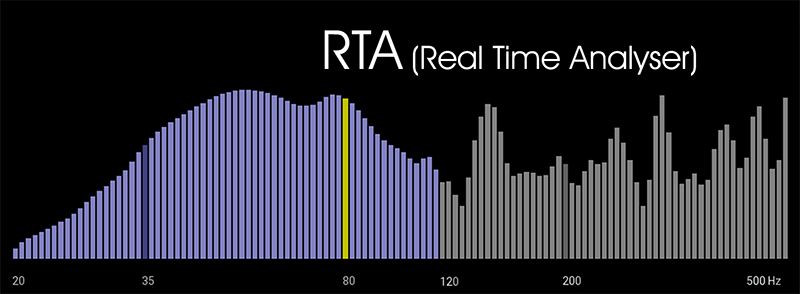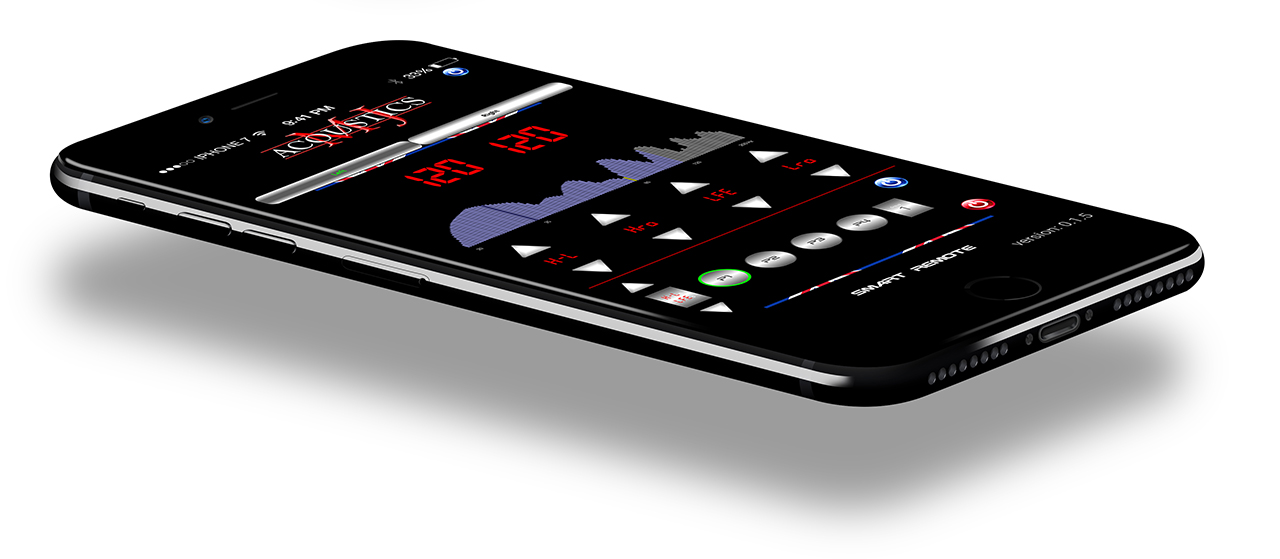Phase? – how do I get this set for my system:
The ideal room size ratio can be represented by a 4m x 6m room in general terms, which is the easiest room size to configure. Scaled-up sizes in the same ratios also make for relatively easy setup and integration producing superb results. Generally speaking the more square a listening room is the more challenging the integration. Furnishings all play a very important part. The more absorbent a room is with soft furnishings and carpet the better the sound stage. In a heavily carpeted room with drapes and walls covered in fabric wallpaper, the treble notes are absorbed much more as too are the bass notes. Both these ends of the audio spectrum can be adjusted with the addition of boost and cut at the required frequencies. However, in a smaller squarer room with less absorbent furnishings, the room is said to be a bright room. In effect what happens is the top frequencies are louder and sharper and the bass is more woolly and potentially overpowering. The woolly bass and dreaded “overhang” are more often than not incorrectly attributed to the newly installed subwoofer. This is an unfair critique of a properly designed subwoofer and would only apply to subwoofers without infinite adjustments in the important settings of Phase, Crossover & Gain. It is important to be able to match the subwoofer with the system as a whole and when this is achieved the subwoofer can be said to have integrated into your audio setup as though it was part of the main speakers. This is true whether they be large floor standing or small bookshelf types.
From the bass end of the audio spectrum, it is important to make sure that we understand, we are not trying to add additional bass to a pair of well well-designed speakers. What a properly dialled-in subwoofer will provide, is the seamless integration at the lower octaves that extend downwards, the overall bass frequencies available to the listener. Starting from the point at which the main speakers drop their output by 3dB. That is why the -3dB figure for the bass specification of the speakers is so important to establish. We must first establish the frequency that the system speakers are rolling off. Then using this value we can establish the correct Phase and Gain adjustment for the subwoofer. The position of the listener to the speakers and the position of the subwoofer to the listener is vitally important to remain the same whilst determining the phasing values. An MJ Subwoofer provides you with the adjustment parameters required to accurately set the values required.
In the complete absence of meaningful specifications for your speakers (some manufacturers do leave this out of the instruction manuals), we can only experiment using a combination of tried and tested procedures and relying on the human ear to detect the appropriate values. Don’t fear the process is quite simple with an MJ Acoustics subwoofer when equipped with “Smart Remote”, you have all the tools required to achieve the desired results. All from the comfort of your listening position!
How do we determine the speakers’ Roll Off value?
the easiest way is to use the specification of the manufacturer of your speakers but in the absence of this important value, the most accurate way to achieve this is to make use of a Real-Time-Analyser (RTA). This clever device converts the audio frequency samples taken from a microphone and displays this as a chart or graph that shows a wave-like image of the frequencies coming from the speakers. The microphone should be placed at the ear level of the listener and at the position the listener will be seated. Slight deviations from the exact position are expected for this exercise and will not manifest in any notable error in determining the roll-off value.


PHASE SET UP
Procedure
The process of setting up an MJ subwoofer requires a few things to be decided and fixed first before any adjustments can be made. This is because the phase and refractional effects of phase adjustment change with differences in equipment position. Also, the cut-off frequency for speakers is often not as the manufacturer describes, when in an owner’s room. The effects of furnishings and speaker toe angle can have profound differences in results.
So the reality is that a subwoofer used to enhance the speakers in an audiophile 2-channel system, when set up and integrated correctly, is considered to be part of a system as a whole. In our opinion, you cannot integrate a system individually by turning one or the other off to determine settings for the phase.
First. Set is the listening position relative to the speakers. This does assume that you have set the speakers up already in accordance with the manufactures recommendations and they are sounding as you desire, albeit lacking in some lower-end substance.
Second. Set the position of the subwoofer relative to the speakers and your listening position.
when the above is fixed you can begin the process of integrating the subwoofer with the speakers in your listening room.
Now we need to determine -3db point that your speakers reach. Our experience has shown us that, as a starting point for the purposes of initial integration, you should use the manufacturer’s specification, so if your speakers are specified as having a -3db point of 35hz then this would be the frequency setting on the crossover in the subwoofer.
In order to determine a more accurate -3db point in your room, you can use measurement equipment. (We are not able to offer assistance for this equipment and we would refer you to the company that manufactured it or the store that sold it to you for assistance if the manual provided is not helpful.)
Without the subwoofer switched on you can use this measurement equipment to determine the -3db point for your room and at the fixed location of the listening position and the position of the speakers. Let us assume that you have done this or decided that the specification offered by the speaker manufacturer is acceptable for this purpose.
Having dialled in the frequency cut-off point of (for the purposes of this example) 35Hz we now have to make sure the phase of the subwoofer is aligned with the speakers at this cut-off point. This is the area that causes the most confusion. Simply put, the phase of the subwoofer has no relevance unless in a system with a pair of speakers that offer low-frequency extension down to or below the possible capability of the subwoofer. The issue we are trying to guard against is Bass Duplication and Bass Cancelling and the resulting Overhang or Bass Boom that often results from a poorly setup system. To illustrate this in an example consider using your subwoofer with tweeters only. Most tweeters do not offer output below 2kHz so you can see that adjusting the phase will have no possibility of inducing Bass Duplication or Bass Cancellation or Overhang or Bass Boom.
Phase set up for a single subwoofer.
We are developing a software application that will correctly determine the phase setting for you. Until that is complete and available we continue to use the time-old method of the human ears. More specifically, your ears. In reality, the use of our own ears is still a great method because ultimately the result is to be pleasing to the listener and all humans are very slightly different in their perception of the frequencies. As we get older, for example, our ability to hear higher frequencies tend to lessen because the natural aging of the muscles and tissues in our ear makes them less agile. This leads to a reduction in perceived treble when compared to a younger person.
Having set the crossover point on the subwoofer we suggest you use a piece of music that has a repetitive bass rhythm in the lower region of the frequency spectrum, as close to the 35hz in this case as possible. Turn up the subwoofer gain to produce a higher output of bass such that the subwoofer can be considered dominant. Then adjust the phase on the subwoofer from zero to 180 degrees until you consider that the bass from the subwoofer is at its loudest. This could be at any phase setting between the minimum and maximum but is solely dependent on your perception and the room’s acoustics. If the result is 75 degrees then that is the setting of the phase for the subwoofer with your speakers and in your listening room with the speakers and subwoofer position at that time. Any change in the above will result in a change in the phase and a repeat of the procedure is required.
Phase for a pair of subwoofers.
The above procedure should be carried out for both the left subwoofer and the right subwoofer independently by turning off the subwoofer not being phased for each procedure. When complete for each, remember to save the settings in one of the memory locations or make a note for future reference. (always a good idea to make a note for future reference).
Having set the phase you can then reduce the gains such that they are inaudible and make sure both subwoofers are on. The gain should now be set by playing the same piece of music and raising the gain on both until the subwoofer bass production is just noticeable to your ears. We suggest backing off the gain by 1 or 2db from the “just noticeable” point. This will form the basis of a great starting point for the long-term integration because the mechanical parts of the driver will ease over the running-in period and output will increase as a result. This is most noticeable for new products though for the first 150 hours of use.
As a visual reference, you can use the RTA function on the “Smart Remote App” or the spectrum analyser in your measurement software to show the real-time graph of the frequency spectrum. It should be noted that in many cases where a user has set up the system by ear it shows that the bass level shown by the graph is considered higher than the expectant flat line often thought to be the ideal result.
Remember that with all these things the end result is to be pleasing to you the listener, even if this means the levels are higher than expected.
Not to give you the impression that your setup procedure will be a never-ending session of tweaking, but the drivers in the MJ’s will loosen up over about 150hours or so and as this happens so too will the depth and output efficiency. You will find that you are making small adjustments regularly until it settles down to a constant.
Happy Listening!
